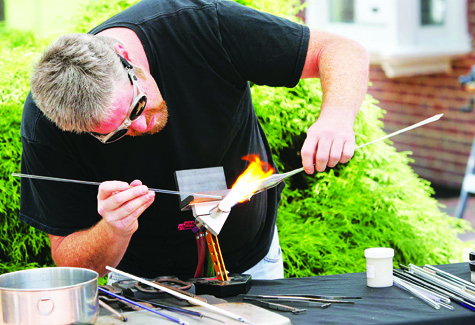Local glassblower on cutting edge of growing artisanal field

John Jude Garvey was a clerk in the bond market in New York City when he first learned how to use glass to create intricate jewelry. He spent long hours on the trading floor at his intense job, and when he took over his father’s investment consulting business and began managing the finances of high-net-worth clients, it became even more stressful.
Today he may seem to be a low-key Greenport shopkeeper, whose blown glass pendants and jewelry turn heads whether the pieces are sitting in a display case at his John Jude Glass Art Gallery or gracing a woman’s neck. But after 50 hours a week minding his shop, he’s up at four every morning at his home workbench making more glass creations.
In the time since he first began blowing glass as a hobby in the mid-1990s, Mr. Garvey has trained for his new career with as much discipline and fervor as he brought to the trading floor.
He’s studied with the best glassblowers in the world and cultivated friendships with some of the finest scientific glassware workers, including the former head glassblower at Brookhaven National Laboratory, Barry Lafler, who ran a Kodak program to provide mirrors for NASA.
Mr. Garvey is an active participant in the Art Glass Invitational, an annual glassblowing convention in Pennsylvania. And he is one of the few glass artists on the East Coast who specialize in small, intricate pieces that are used as jewelry and adornment.
While working on the stock market, Mr. Garvey also worked as a freelance web designer, and he began designing the website for Flow magazine, which chronicled the glassblowing industry. That job quickly catapulted him into the milieu of professional glassblowers.
“I always felt drawn to doing something artistic,” he said. “I wanted to be M.C. Escher. When I did my first glass class, the instructor said, ‘Oh, you’ve done this before.’ But I hadn’t, I just had a knack. I got burned and I just switched hands. That’s how he knew. You’re going to burn yourself doing this. I get cuts all the time. It’s an addiction. You’ve got to have it in your blood.”
In the United States, he said, glassblowers who want to pursue higher education in their craft are limited to getting an associate degree. In other countries, however, where the history of glassblowing is longer, formal education and apprenticeships can last as long as a decade, with young glass workers honing their techniques under the watchful eye of professionals who somehow manage to recreate work they’ve done before despite the temperamental nature of glass. After their training, the young workers begin to develop their own unique styles.
But Mr. Garvey has already set his own stylistic trend in the U.S.
His pendants, wine bottle stoppers, rings and most other creations are made of borosilicate, the same glass compound used to make Pyrex dishware, and are nearly unbreakable. Many other glass workers specialize in a soda-lime glass, known in the industry as “soft glass,” which is highly breakable when dry but melts at a lower temperature, making it easier to work with.
“If your hand hits a table made of soft glass, [the table] will break,” he said.
Earlier art glass work was done almost exclusively with soft glass, he said, in part because colored borosilicate was not commercially produced and glass workers who used hard glass had to add metal oxides to create different colors. That has changed in the past decade, with many more suppliers offering hard glass in a variety of colors, just in time for Mr. Garvey’s entry into the glassblowing world.
In addition to embedding the outlines of flowers and other natural features in his pendants, Mr. Garvey uses a highly temperamental glass compound known as dicrosilicate in his work, creating a sparkling, almost fireworks-like effect.
“It has a great effect, but it’s very difficult to work with,” he said.
Mr. Garvey moved full-time to his family’s house in East Marion 12 years ago, in order to raise his teenage daughter on the East End. He quit his work in the city and began traveling the country to attend craft shows with his glass creations, before opening the gallery three years ago in the brick alcove across from Mitchell Park. He can often be seen in there, giving glassblowing demonstrations under a shade tent.
In his shop, he sells both his own work and that of friends and mentors in the industry, who have become a sort of extended family as he’s delved deeper into his craft.
“I could not believe how much of a family environment it is,” he said of the glassblowing community. “The first time I was at the Art Glass Invitational, I felt totally out of sorts, with all the masters there. They used to talk about a ‘glass curtain.’ In Murano, Italy, where the glass was made, they’d have to kill you if you told people how it was done. Now it’s a very giving community. The masters show you how to do what they do.”








